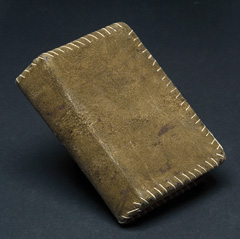
In early 1943, the pocket-size LDS serviceman’s edition of the Book of Mormon was released. Many benefited from this easy access to the Book of Mormon, among them was Boyd K. Packer. Voracious reading of the Book of Mormon influenced his life during and after the war. Speaking at a February 2003 Church Educational System fireside, President Packer talked of his war experiences and his gratitude for the Book of Mormon.
 Boyd K. Packer and his B-24 Bomber crew mates. Packer is in the first row, left.
He was the co-pilot. Courtesy of President Boyd K. Packer family.
Boyd K. Packer and his B-24 Bomber crew mates. Packer is in the first row, left.
He was the co-pilot. Courtesy of President Boyd K. Packer family.While in training camp, Packer began the habit of reading the Book of Mormon during downtime or waiting his turn in a line. I was in the military — had not been on a mission, had not had any college, and often was alone. We often are alone, all of us, in our lives. I became a product of the Book of Mormon. Constantly with him, his Book of Mormon bears the marks of diligent study evidenced by bold and colorful markings throughout its pages.
 Boyd K. Packer's Book of Mormon
Boyd K. Packer's Book of MormonI have here a small, serviceman’s copy of the Book of Mormon. It is bound in leather, real leather. I picked up an old leather pilot’s flight jacket in the wreckage of our headquarters on the little island of Ie Sima in the Ryukyu Islands. It was wet, and the building was torn all to pieces. Everything on the island was destroyed by a hurricane. I rescued the old leather pilot’s jacket from the wreckage.
The cover of my Book of Mormon was getting very torn, so I gave it a leather cover, genuine leather. I sewed it on myself. The bindings I took from the strings of a parachute that likewise had been ruined.”

His careful care of his Book of Mormon indicates his gratitude for a prized possession. When Packer came to the end of the Book of Mormon, he heavily marked Moroni’s promise. One evening he had a strong desire to know if the Book of Mormon was true.
It was a clear night. After some moments I determined to ask; to really ask for some consolation, some indication to strengthen me. I wanted a testimony. I had studied the scriptures; we had tried to teach one another. I had tried to perfect myself according to the meager knowledge I had. I felt a compelling inward need for some spiritual consolation.
Then I knelt to pray. Almost mid-sentence it happened. I could not describe to you what happened if I were determined to do so — and I am not! It was, as Brother McConkie often said, “Beyond my power of expression.” I knew it to be a very private, a very individual, manifestation. At last I knew! I knew for a certainty. (Quoted in Boyd K. Packer: A Watchman on the Tower, 60).
 Boyd K. Packer as an air cadet, 1943. Courtesy of President Boyd K. Packer family.
Boyd K. Packer as an air cadet, 1943. Courtesy of President Boyd K. Packer family.Following V-J Day, Boyd K. Packer was stationed in Osaka, Japan. His biographer, Lucile C. Tate, in Boyd K. Packer: A Watchman on the Tower writes the following:
As [Packer] filled new flight assignments he became acquainted with an educated Japanese gentleman, Tatsui Sato, a Christian, who had been taught the gospel by Ray Hanks and C. Elliott Richards. Both Tatsui and his wife, Chio, knew that what these men had taught them was true, and shortly after Boyd’s arrival in Osaka they accepted the challenge to be baptized. A spirit of kinship immediately existed between Boyd and this man’s family. Boyd felt the potential of Tatsui in service to the Church.
The Satos’ young son, Yasuo, told his father that Boyd would some day be a great man in the Church.
The Satos’ baptisms — the first in Japan since 1924, when the Japanese mission was closed — took place 7 July 1946, after the morning session of conference. About 150 LDS servicemen and a few Japanese people came fasting to the meeting. At its close they went out from the city of Osaka to Kansagakwin University, which had been largely destroyed by bombs. There stood what was left of a once-beautiful swimming pool and enough bathhouses intact for the participants to change into white clothing.
After a poolside service Elliott Richards baptized Tatsui and Boyd baptized Chio. From that time the Satos always called Elliott and Boyd their sons.
Tatsui Sato, that choice convert to the Church, was later to retranslate the Book of Mormon into Japanese. (65-66)
The Satos felt great gratitude and thanksgiving for this young, righteous man who was “a product of the Book of Mormon.”
LDS Serviceman's Edition of The Book of Mormon
Book of Mormon. Salt Lake City: The Church of Jesus Christ of Latter-day Saints. First issued in pocket-size edition for men in the Armed Forces, complete with all features of the 1920 edition, in 1943.

In 1943, the pocket size LDS serviceman’s edition of the Book of Mormon was released. Many benefited from easy access to the Book of Mormon, among them was Boyd K. Packer. Voracious reading of the Book of Mormon influenced his life during and after the war.

